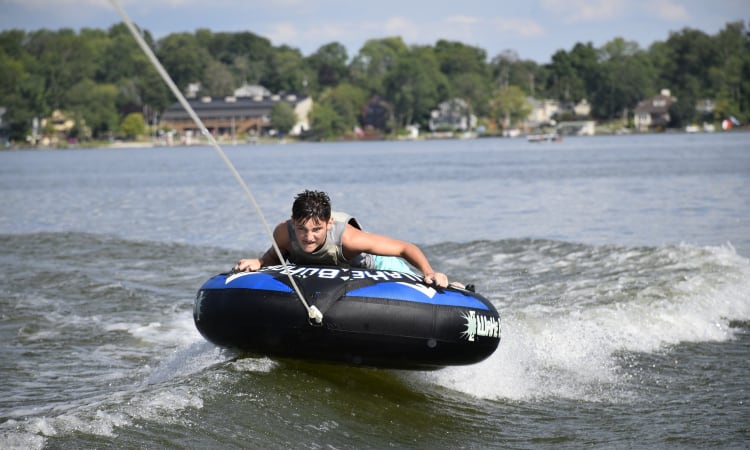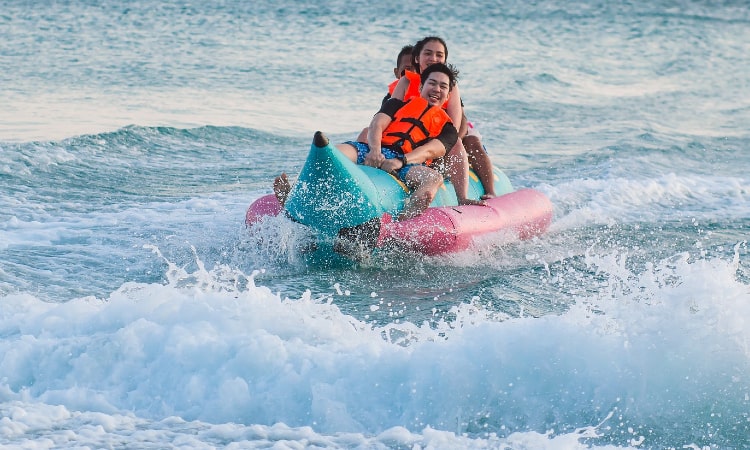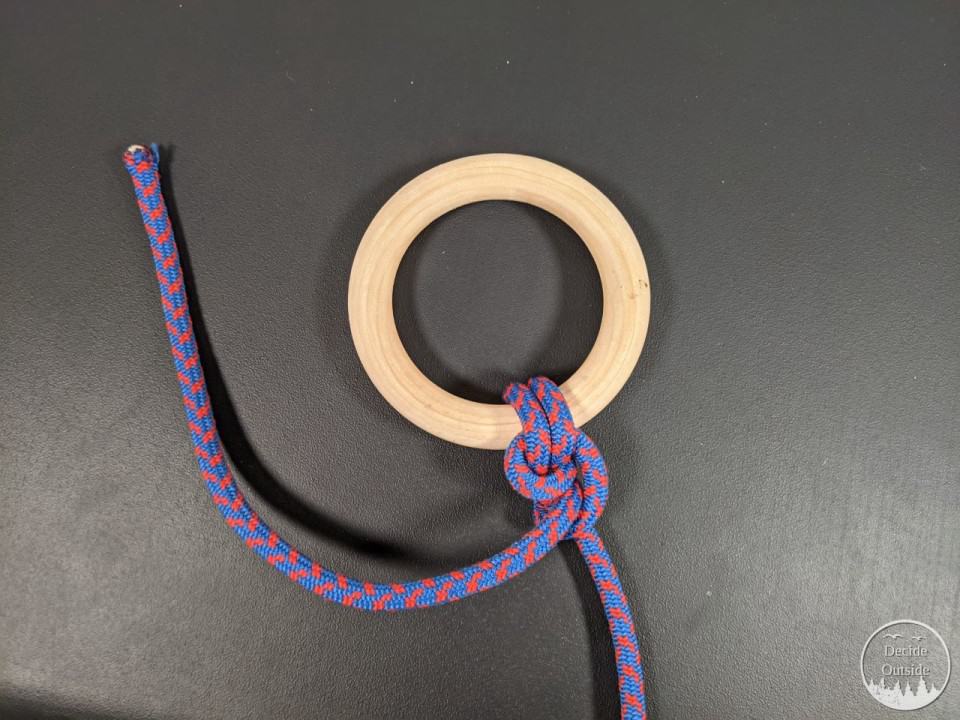
Whether you love fishing or just cruising around the lake, pontoon boats are a great way to spend time on the water with family and friends! But did you know that pontoons boats are also great for pulling tubers? However, there are some things that you need to know before strapping on a rope and tube to the back of your boat!
To help you out with ensuring a safe and fun trip for everyone, here’s how to tow a tube with a pontoon boat, in 7 simple steps!
To make sure that everything remains up to speed, you need to check every detail of the boat and its attachments. One of the critical attachments is where the towing rope is hooked to the pontoon. It has to be one-thousand-percent sturdy, with no allowance at all for glitches.
By the way, as an Amazon Associate, I earn when buying qualified products through links on my site.
Step 1: Get the Essential Numbers
To get the correct specifications of the tow rope and harness configuration, you need to know the force that needs to be towed. A factor of safety should be added after that, to minimize any risks. The basic figures are as follows:
- The max number of tube riders
- The weight capacity for the tube
- The motor power of the pontoon boat
- The number and average weight of pontoon passengers
To get a general idea of what these numbers could add up to, towing a single 170-lbs. rider requires a rope of tensile strength 1500 lbs. while towing 5 riders with an average collected weight of 850 lbs. needs a rope of tensile strength 6100 lbs.
A pontoon boat with a medium powered motor, and around 5 passengers, would lug a 5-rider tube slowly on the river. Another pontoon, with a stronger motor and just a couple of passengers, can sweep a tube rider off the water surface in an incredibly swift cruise.
Getting a full idea of your setup pays off in the amusement you and your group will get. If you want speed, get a boat with the high HP motor. If you have a lot of youngsters aboard, then your good old pontoon with the meandering motor would serve you well, speed would not be necessary for that family trip.
Step 2: Choose a Suitable Tube
The towing setup you’d need is highly dependent on the kind of tube you’ll be towing. Here are some of the factors to consider.
Usage and Intent
- Choose the tube design that fits your intended usage. A tube that’s good for little kids (check out our article for examples), might not be the best choice for a group of teens.
- You could go for a simple donut-shaped tube. Or, you can get an elaborate design. Deck tubes are another popular choice, as they allow the waves to really lift up the riders.
- There are many other innovative tube designs. Whichever one you pick, your choice would most probably impact the harnessing and towing rope specifications.
Pontoon Boat Space Limitations
- The tube won’t always be deflated. Once it fills up with air, it’ll occupy a significant amount of space. If your boat would be cramped with a large tube, get a smaller one.
- Notice that this would affect the towed weight capacity and all the ensuing requirements for the rope and harness.
Max Number of Tubers Allowed and Weight Capacity
- The number of riders is implied by the number of handles on the tube. The weight capacity is a pointer to the possible number of riders.
- Some people fill the weight capacity to the brim with thinnish riders. But even if the weight allows it, don’t go beyond the indicated number of riders. The space allocations and presence of handles for each rider keep things safe.

Step 3: Pick the Right Rope
As we mentioned in the previous section, the design of the tube will impact the technicalities of the towing rope (check out this one on Amazon). Also, whether the tube will be used for speeding or for easy cruising will dictate the right kind of rope.
Sometimes a bit more give or elasticity is needed in the towing rope, some are as elastic as bungee ropes. The more elastic, the more whip the riders will experience.
The water sports standards recommend that a rope length between 50-65 feet be used to tow the tube. If the length is shorter, the water from the boat wake will splash in the riders’ faces. Longer ropes make the tube harder to maneuver and control.
There are many types of towing ropes on the market. Use only the ones designed for this specific sport. The weight capacity and dynamics vary significantly from one water sport to the next. Also, make sure that the rope isn’t frayed, and that it has no knots anywhere along its length.
Going slow or towing a light load tends to decrease the tension in the rope. This naturally lets it sink under the water surface, which has a negative effect on the towing experience. A good solution would be using a bobber or a booster ball (such as this one on Amazon), to improve the rope placement, and stabilize the rope tension.
Step 4: Pick the Right Harness
Pontoon boats are relative latecomers in the world of towing water sport objects. That’s why not all of them have the necessary horsepower or the right attachments for the job. The alternatives include the tow bar, eyes, grommets, or cleats.
Where To Attach Tow Rope On A Pontoon Boat?
The best option is the ski tow bar. This guarantees the best load distribution on the body of the boat. It’s also sturdy enough to keep the towing rope stable and hanging above the water level.
Be warned, though–a typical ski tow bar is meant to tow a single water-skier, which is a completely different story compared to a tube. Make sure your tow bar is rated for tubes.
One example of something you can use as a tow bar is the Turboswing–it’s a bar that wraps around the prop so you don’t have to worry about two attachment points and is strong enough for tubes and skiers:

Two-Point Attachment
The next best thing is the two-point tie-in. A y-rope harness attachment (like this one on Amazon) is necessary in this setup, with the right specifications for each towed load of course. Several professionals also advise looping the towing rope once or twice around the two-point attachment.
You can of course make your own y-rope harness attachment by tying a loop at the end of your rope and then tying two exactly equal-length ropes to the loop (I’d use a double anchor bend to attach the two ropes to the loop). The two lengths of rope can then be tied to both sides of the pontoon boat.

The two rope lengths that you can tie to the pontoons need to be long enough so as to not interfere with the props from the motor.
Some people try to tie the towing rope to the tower, but that’s highly discouraged. This structure was not designed to carry that kind of horizontal dynamic load.
Step 5: Tie the Knot
Tying the rope correctly is just as important as choosing the right kind, and attaching it in the proper spot.
My go-to knot for tying rope to a fixed loop is the anchor bend (see a picture of it above). If you’d like to learn how to tie knots, make sure and check out my course, here.
Nautical knots are an art form just as much as an engineering feat. Remember to keep the towing rope free from any knots along its length. The sturdy knots go at the towing bar/two-point attachment, and at the tie-down point with the tube.
Some tubes come with quick-connect clips/carabiners, so an extra knot there would not be necessary.
Step 6: Make Sure Everything is Safe
Ensuring the safety of everyone onboard does take time, but it can make the difference between a fun family outing and a disaster.
Here are some safety points to keep in mind:
- Everyone needs a PFD (lifejacket). You have to use your own judgement when it’s okay to take it off, but this isn’t something you should do without.
- Make sure everyone has a type II life jacket (boatus), that fits properly, and is fastened securely.
- A pontoon should tow a single float. Attaching more than one could end up in a collision.
- The driver should be sober and fully aware of his surroundings.
- A designated spotter should keep an eye on riders at all times.
- The spotter should keep a flag up and visible whenever there is someone in the water.
- The spotter, riders, and driver should agree on specific signs to communicate at a distance.
- Adjust the speed according to the needs of the riders, slow down with kids.
- Riders should respect the tube weight capacity and passenger numbers.
- The tube and ropes should be inspected thoroughly ahead of time.


Step 7: Have Fun!
That’s really the whole point of this drill! Make sure everyone has a great time, starting with you. Watersports are among the most refreshing and adrenaline-pumping activities anyone can take on.
Can You Tow a Tube With a Pontoon Boat?
I wanted to summarize for anyone who might still be doubting– you can absolutely tow tubes with a pontoon boat. You need a big enough engine (115HP is a good starting point), a ski/tow bar that’s strong enough for tubing (or a y-rope and two attachment points), and a strong enough rope (anywhere from 1500 to 6000+ lbs tensile strength depending on how many riders).
How Big Of An Engine Do You Need To Pull a Tube?
To be able to tow in the 20-25 mph range, you will likely need to have at least an 115 HP engine. You can tow with less powerful engines but that means your speed will be much lower.
This is a much more complicated question than you may realize. Pontoon boat speeds and power depends on motor size, boat length, how much gear is stowed, number of passengers, the way the boat sits in the water and if the pontoons have lifting strakes. That’s just a few of the variables. If you want a full analysis of how to get faster pontoon boat speeds, make sure and check out our article, here.
Conclusion
That was our full guide on how to tow a tube with a pontoon boat.
Check the requirements first. Then, choose the right tube, rope, and attachment. Inspect all your gear, and assign a trusted driver and spotter. Consider the safety points listed above, and double check each item if you have to.
Finally, enjoy a wonderful day with friends and family!



